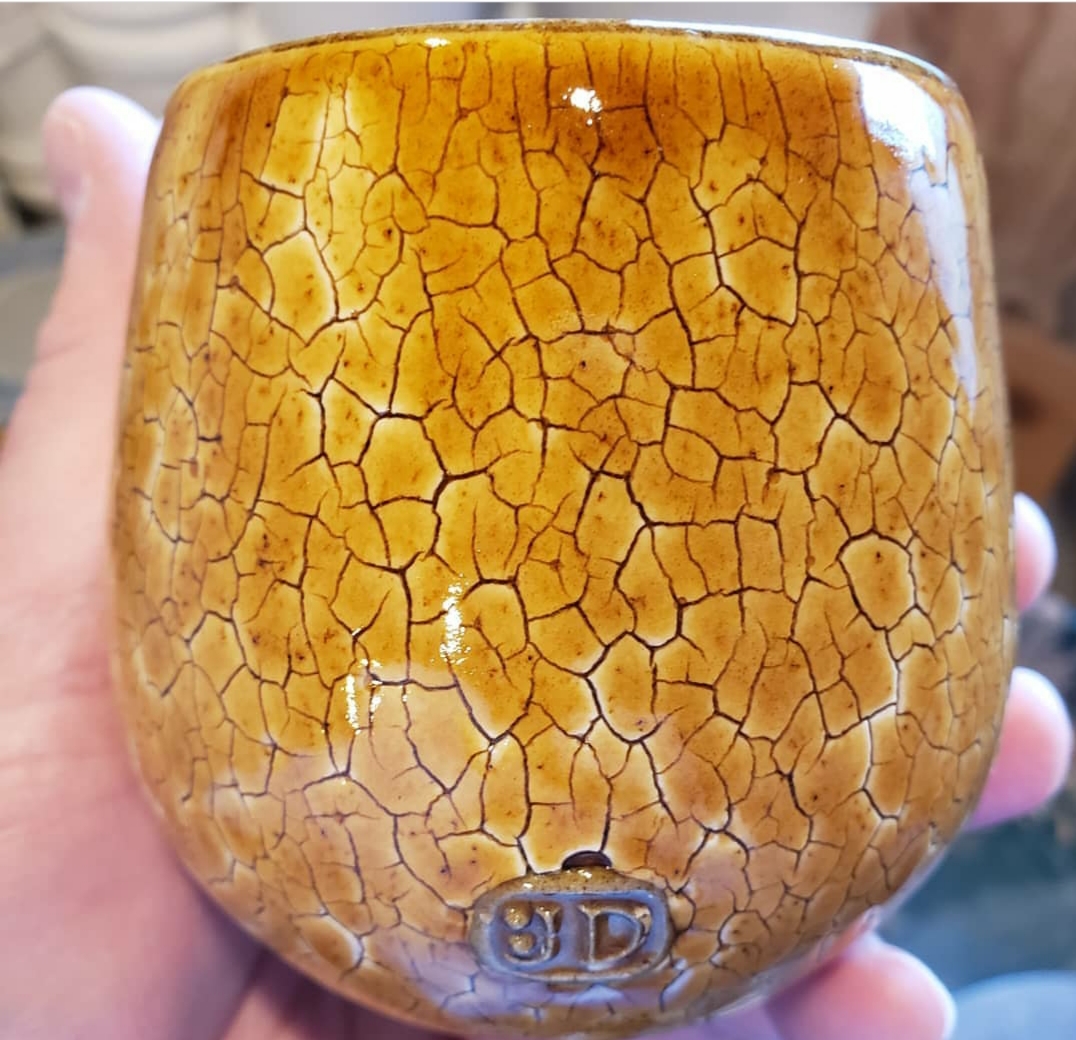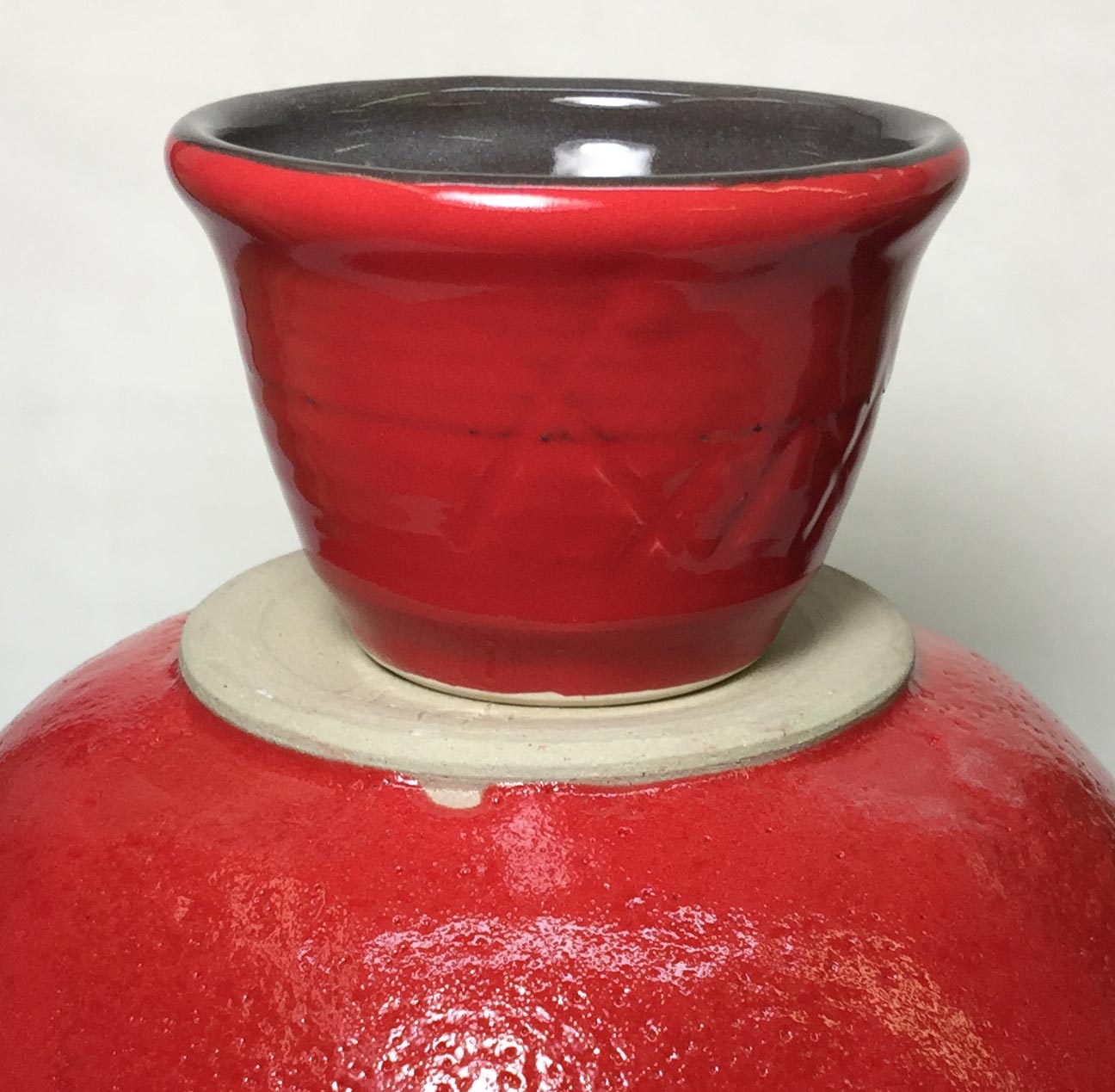| Monthly Tech-Tip | No tracking! No ads! | |
Orange Peel Surface
Orange peel is a defect or physical property of ceramic glazes
Details
Ceramic glazes can have a surface texture like orange peel, this can be intentional or a defect. Matte glazes, depending on their mechanism, can have a smooth but dull or a bumpy but glossy surface (the bumps are very fine and scatter the light to produce a silky matteness). Variegated glazes having phase differences can also have an orange-peel surface. Glazes with significant entrained bubbles and those not sufficiently melted can also have a rougher peel surface.
Assuming the glaze is sufficiently melted, a firing cycle having a slower cool can help level the surface of glossy glazes. If better melting is needed the recipe can be adjusted to have more fluxing oxides. Adding some frit can really help (e.g. Frit 3195 has balanced chemistry and will often help melt glazes with minimal impact on other properties). If the glaze also has issues with crazing Ferro Frit 3249 (or equivalent) can help solve both problems. If the rough surface is caused by excessive gas bubbles being generated during firing then adjusting the glaze recipe to source the chemistry from materials having a lower LOI can really help (e.g. Gerstley Borate and frits both source B2O3 but the former has a very high LOI). Carbonate materials can generate lots of orange peel producing bubbles at the wrong time. Strangely enough, stains can be a source of bubbles also, try a different one to be sure. If the body is gassing then a drop-and-hold at the end of the firing will really help. Slow cool from there will help even more. If the glaze has a stiff melt (e.g. is high in Al2O3) the chemistry can be adjusted to raise the SiO2 and drop the Al2O3. High MgO glazes naturally have an orange peel surface (MgO is from talc and dolomite). That being said, some MgO can be tolerated, in ultra gloss surfaces, but when a threshold is reached surface texture is affected.
Sometimes the best approach is to transplant the fired mechanism-producing materials in the recipe (the ones giving the color, variegation and opacity) into another base transparent that works well on your clay bodies.
This will resolve another possible issue: A bad shipment of frit. A different clear base that uses a different frit would be a good test to verify that.
Related Information
A honey glaze that needs a base having more melt fluidity

This picture has its own page with more detail, click here to see it.
This transparent glaze adds a little manganese and iron, just enough to give color, but still maintain transparency to highlight the decorative crack-network in the engobe below. However this glaze is not as brilliant and transparent as it could be. As apparent in the surface reflections, it has somewhat of an "orange peel" texture on the glass surface. This is due to a combination of factors (e.g. not enough melt fluidity, gassing of the manganese during melting, cooling the kiln too quickly). If the colorants were transplanted into a more fluid-melt transparent, this glaze could be improved. Photo courtesy of J. Decker.
Orange-peel or pebbly glaze surface. Why?

This picture has its own page with more detail, click here to see it.
This is a cone 10 glossy glaze. It has the chemistry that suggests it should be crystal clear and smooth. But there are multiple issues with the materials supplying that chemistry: Strontium carbonate, talc and calcium carbonate. Each has a significant LOI and produces gases decomposition. When the gases need to come out at the wrong time it turns the glaze into a Swiss cheeze of micro-bubbles. A study to isolate which of these three materials is the problem might make it possible to adjust the firing to accommodate it. But probably not. The most obvious solution is to just use non-gassing sources MgO, SrO, CaO and BaO (which will require some calculation). There is a good reason to do this: The glaze contains some boron frit, that is likely kick-starting melting much earlier than a standard raw-material-only cone 10 glaze. That fluid melt may not only be trapping gases from the body but creating a perfect environment to trap all the bubbles coming out of those carbonates and talc. All of this being said, a drop and hold firing schedule could also smooth it out a lot.
Zircopax as a fining agent to de-bubble a stained glaze

This picture has its own page with more detail, click here to see it.
The cone 03 porcelain cup on the left has 10% Cerdec encapsulated stain 239416 in the G2931K clear base. The surface is orange-peeled because the glass is full of micro-bubbles that developed during the firing. Notice that the insides of the cups are crystal-clear, no bubbles. So here they are a direct product of the presence of the stain. The glaze on the right has even more stain, 15%. But it also has a 3% addition of Zircopax (zircon). Suppliers of encapsulated stains recommend a zircon addition, but are often unclear about why. Here is the reason: It is a "fining agent".
Glaze with an encapsulated stain is bubbling. It needs Zircopax.

This picture has its own page with more detail, click here to see it.
These two pieces are fired at cone 6. The base transparent glaze is the same - G2926B Plainsman transparent. The amount of encapsulated red stain is the same (11% Mason 6021 Dark Red). But two things are different. Number 1: 2% Zircopax (zircon) has been added to the upper glaze. The stain manufacturers recommend this, saying that it makes for a brighter color. However, that is not what we see here. What we do see is the particles of unmelting zircon acting as seeds and collection points for the bubbles (the larger ones produced are escaping). Number 2: The firing schedule. The top one has been fired to approach cone 6 and 100F/hr, held for five minutes at 2200F (cone 6 as verified in our kiln by cones), dropped quickly to 2100F and held for 30 minutes.
Links
| Glossary |
Drop-and-Soak Firing
A kiln firing schedule where temperature is eased to the top, then dropped quickly and held at a temperature 100-200F lower. |
| Firing Schedules |
Plainsman Cone 6 Drop-and-hold, Slow Cool
350F/hr to 2100F, 108/hr to 2200, hold 10 minutes, fastdrop to 2100, hold 30 minutes, 150/hr to 1400 |
| Materials |
Copper Carbonate Basic
This form of copper carbonate is the article of commerce, a mixture of theoretical copper carbonate and copper hydroxide. |
| By Tony Hansen Follow me on        |  |
Got a Question?
Buy me a coffee and we can talk

https://digitalfire.com, All Rights Reserved
Privacy Policy
